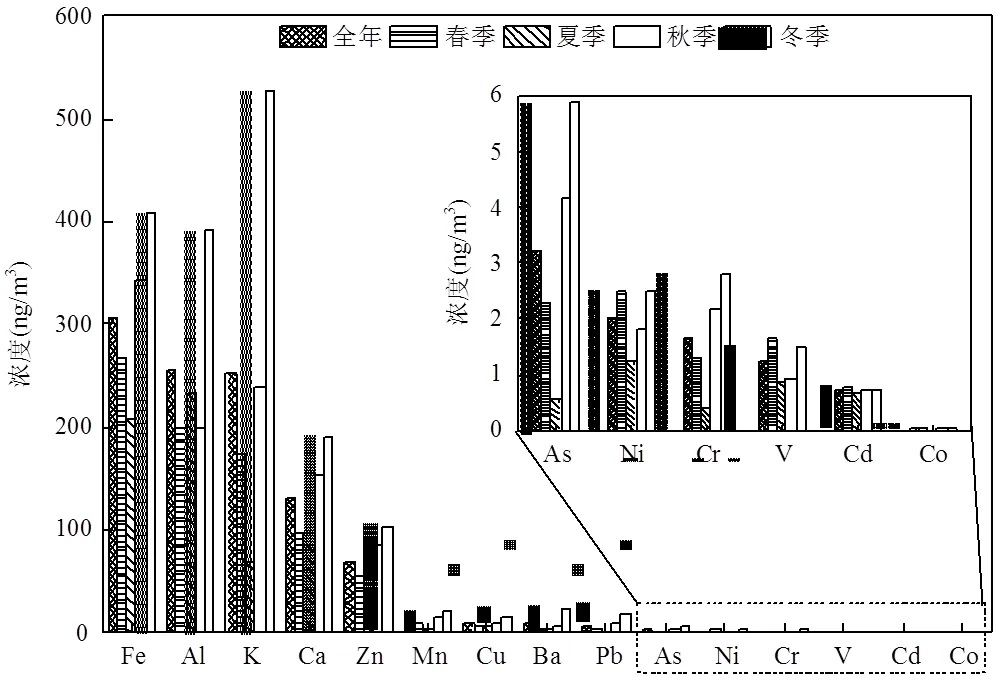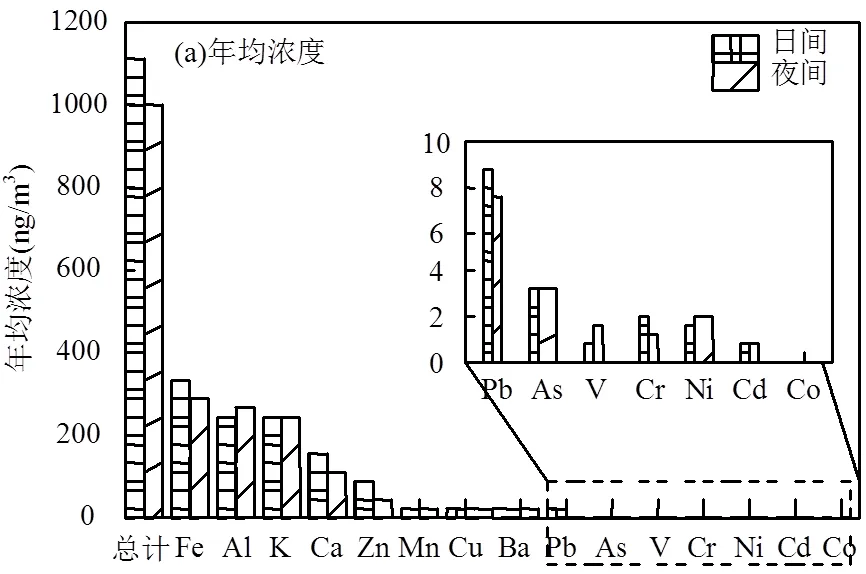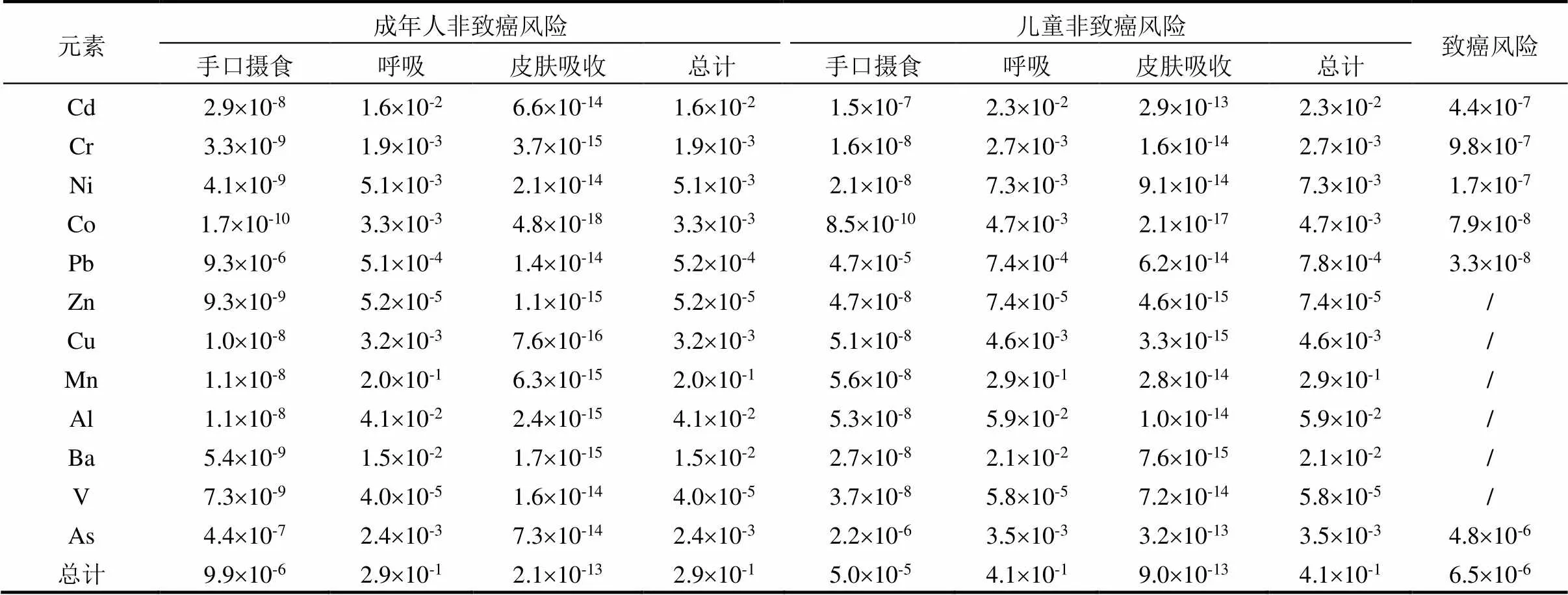深圳市大气中PM2.5载带金属污染特征及健康风险
古添发,闫润华,姚沛廷,林晓玉,罗 遥,曹礼明,张明棣,黄晓锋*
深圳市大气中PM2.5载带金属污染特征及健康风险
古添发1,闫润华2,姚沛廷2,林晓玉2,罗 遥2,曹礼明2,张明棣1,黄晓锋2*
(1.广东省深圳生态环境监测中心站,广东 深圳 518049;2.北京大学深圳研究生院环境与能源学院大气观测超级站实验室,广东 深圳 518055)
于2020年3月~2021年2月对深圳市道路环境空气中PM2.5载带的15种金属元素的质量浓度进行时间分辨率为1h的全年在线观测.结果显示,深圳市道路环境空气中PM2.5载带金属元素的总平均浓度为(1062.3±434.6) ng/m3,其中Fe、Al、K、Ca和Zn为主要贡献元素,在金属元素中总贡献达到95.5%.Fe的浓度较高,受到与道路扬尘和机动车排放的强烈影响.金属浓度存在着显著的季节性差异,冬季浓度最高(1709.3ng/m3),夏季最低(644.1ng/m3).Mn、Fe、Cr、Zn和Ca元素呈现明显的双峰日变化分布,与机动车流量高峰一致.昼夜浓度分布结果显示,夜间船舶排放V和Ni的浓度高值得关注,而Mn、Zn和Ca的浓度白天较夜晚高,与白天机动车流量较高有关.高污染日总金属日间浓度和夜间浓度均为全年日间和夜间平均浓度的1.9倍.成年人与儿童暴露于深圳市道路环境空气的非致癌风险均低于阈值1,但是总致癌风险(6.5×10-6)超过阈值10-6,且As和Cr(主要来自机动车排放)的致癌风险之和在总致癌风险中占比88.9%,说明交通排放PM2.5载带金属的致癌风险仍值得重视并需持续控制.
道路环境空气;PM2.5载带金属;日变化;健康风险
大气颗粒物表面具有附着各种有毒物质的能力,例如有毒金属和细菌等[1].金属元素是颗粒物中至关重要的毒性成分,人体吸入以后会对呼吸、免疫、神经等多个系统造成直接或者间接的危害.此外,金属元素不仅是大气颗粒物中总质量的重要组成部分,而且具备复杂的环境气候效应.PM2.5具有体积小、比表面积大和活性强的特征,载带的金属(例如Pd、Ni、Cd、Cr、Co等)因其高毒、持久、隐蔽和生物积累性等特点,引起了公众的广泛关注[2].
近年来,国内外对于城市环境空气中PM2.5的金属污染特征和健康风险研究较多.道路环境空气是城市大气的重要组成且来源相对丰富[3-4].以道路环境空气进行大气金属的相关研究相对较少.He等(2008)对中国珠江三角洲地区珠江隧道中PM2.5的排放综合特征研究发现,Fe、Ca、Mg等微量元素丰度较大[5].国外也报道了公路交通排放会影响PM2.5载带微量元素的浓度[6].有研究表明公路环境中,金属元素易富集在细颗粒物中,会引发不利的非致癌和致癌风险[7-8].
2020年深圳市机动车保有量达到359万辆,每公里机动车密度超过510辆,居全国首位(至2020年1月).之前的研究结果表明,机动车排放是深圳市PM2.5的重要来源,约占PM2.5质量浓度的20%[9].深圳市是中国首个达到世界卫生组织空气质量PM2.5中期目标(IT-2,25μg/m3)的特大城市,也是中国发展最快的特大城市之一.因此对深圳市道路环境空气中金属污染特性及其健康风险研究有利于深圳市空气质量的精细化管理,同时也为其他城市污染管控提供了借鉴参考.
1 仪器和方法
1.1 采样点位
本研究采样点位于深圳市东南部福田区深南中路(22.54°N,114.10°E),采样点距离路边约3m,该观测点位为深圳市蓝天工程路边站,以监测道路交通空气质量为目标[10].道路双向8车道,为I类干线,代表了典型的道路环境,且周边无显著工业等其他排放来源.
1.2 金属元素分析
大量的金属元素分析方法基于滤膜离线采样法,尽管离线分析提供了较低的痕量金属检测限,但滤膜采样通常会受到不连续的时间覆盖的影响.特别是对于快速变化的道路环境空气中[11],难以捕捉金属的快速变化.在线测量技术在单个季节或少数严重雾霾事件应用较多[12-13].本研究利用高时间分辨率Xact-625型多金属在线分析仪(Cooper Environmental Services LLC, USA)于2020年3月~ 2021年2月对深圳市道路环境空气PM2.5中的15种元素(Al、K、Ca、V、Cr、Mn、Fe、Co、Ni、Cu、Zn、As、Cd、Ba和Pb)进行在线连续采集与质量浓度分析,时间分辨率为1h,采样流量为16.7L/ min, 元素的检出限为0.06~100(ng/m3).Xact-625型多金属在线分析仪通过PM2.5切割器采集空气,颗粒物富集在滤带,由转轴带入分析区.仪器采用非破坏性的X射线荧光法分析颗粒物,输出采集时段金属浓度值,同时空白滤带部分进行下一样品的采集[14].更多仪器原理详见文献[15].
1.3 健康风险评价
根据美国环境保护署、国际癌症研究机构和综合风险信息数据库,污染物可分为致癌物质和非致癌物质.本研究中Pb、Zn、Cr、Cu、Ni、Mn、Al、Cd、Co、V和Ba为非致癌物质而Co、Pb、Cd、Cr和Ni为致癌物质[16-17].通过计算3个主要暴露途径的平均每日剂量(ADD)来评估PM2.5结合金属的非致癌风险(NCR):手口摄食途径(ing)、口鼻呼吸途径(inh)和皮肤吸收途径(derm).



式中:代表金属浓度(呼吸途径计算单位为mg/m3,另外两个途径为mg/kg).通过将大气浓度(ng/m3)和PM2.5样品的质量浓度(μg/m3)换算得到皮肤和摄食途径暴露的浓度.不同价态的Cr的健康差异不同,测得的Cr浓度需和致癌物Cr(VI)浓度进行替换.本文参考大气中Cr(VI)的浓度是Cr的1/7进行替换[18]. IngR是摄入量,mg/d;ED是指暴露持续时间(儿童6a,成人24a);EF是暴露频率,d;BW是平均体重,kg;非致癌风险AT=ED×365d,致癌风险AT=75.8×365d;InhR为吸入量,m3/d;SA为暴露的皮肤表面积,cm2;CF为换算系数,kg/mg;SL为皮肤粘附因子,mg/cm2× d; ABS为皮肤吸收系数.具体各个参数数值见表1.本文中,儿童和成人的非致癌风险通过式(1~3)计算.
危险商(HQ)计算公式为式4:
HQ=ADD/RfD(4)
式中:RfD是指特定金属的可接受风险水平(表2),然后将危害指数(HI)计算为所有具有非致癌作用的物种的组合.HI或HQ>1表明在成人和儿童的一生中,不良非致癌影响的发生概率很高[19].对于致癌风险(CR),使用来自呼吸暴露途径的终生平均每日剂量(LADD)并计算如式5[20-21]:

特定金属(即Cd、Co、Cr(VI)、Ni、Pb)的潜在致癌风险计算为式6:
CR=LADD´SF(6)
式中:SF表示对应于特定物种的斜率因子,mg/ (kg×d)(表2).由于大多数物种无法获得皮肤吸收或摄食途径的SF,呼吸是先前研究的3种途径中PM2.5的主要暴露途径[22-23],因此根据呼吸途径估算CR.CR可以表示为一个人因终生接触致癌危害而患上癌症的概率.CR的阈值风险定义为1× 10-6~1×10-4[19].1×10-6的目标参考风险是最小风险值,这意味着百万分之一的人可能因此患癌的终身暴露.1×10-4是可接受范围内的最大风险值,这意味着可能会在一万人中发生一个额外的癌症病例.另外,在健康风险评估上,虽然本研究在健康风险评估中已尽可能选择最新的暴露参数和较为全面的金属元素,但依然较难获得特定区域的暴露参数,对于精细化评价深圳市人群整体暴露水平存在局限.

表1 健康风险评估的暴露参数
2 结果与讨论
2.1 深圳市道路环境空气中PM2.5载带金属元素的全年及四季污染特征
研究期间的深圳市道路环境空气PM2.5载带金属全年污染特征分布如图1所示,Fe(306.7ng/m3)> Al(255.5ng/m3)>K(252.4ng/m3)>Ca(131.8ng/m3)>Zn(67.9ng/m3)>Mn(12.5ng/m3)>Cu(9.8ng/m3)>Ba(9.2ng/m3)>Pb(7.9ng/m3)>As(3.2ng/m3)>Ni(2.0ng/m3)>Cr(1.7ng/m3)>V(1.2ng/m3)>Cd(0.7ng/m3)>Co(0.1ng/m3).其中Fe、Al、K、Ca和Zn在金属中总贡献达到95.5%.与之前深圳市环境空气中PM2.5载带金属研究结果K含量最高结论不同[33],道路环境空气中Fe含量较高,这可能与Fe主要来自地壳元素[34],并且受到道路扬尘与机动车排放的影响有关[35].Fe在道路环境空气中含量较高与珠三角地区隧道实验结论一致[5].我国环境空气质量标准(GB 3095-2012)对Pb、Cd和As的限值大气浓度(ng/m3)分别为500、5和6,本研究期间深圳市的金属浓度未超过限值.即使深圳市PM2.5浓度较低,但是其载带金属元素浓度相比很多欧美国家处于痕量水平仍然存在差距[33].
金属元素浓度存在着显著的季节性差异(图1).15种元素总体呈现冬季(1709.3ng/m3) >秋季(1071.8ng/m3)>春季(824.8ng/m3)>夏季(644.1ng/ m3)的特征.这与深圳市PM2.5的季节性分布一致[36].季节性分布特征主要受深圳市的气象条件驱动,秋季和冬季常受东北地区的污染气团传输,另外较低的风速与边界层等不利条件的综合,导致秋冬季节污染浓度的加重.夏季的气团则主要来自于清洁海面,另外夏季降水频次较多,有利于污染物稀释扩散.春季和秋季的主要贡献元素为Fe,分别占比为32.4%和32.0%.夏季的主要贡献元素为Al,占比为36.2%.Al是典型的地壳元素[37],之前的深圳市PM2.5来源解析表明Al的主要来源为扬尘[36].冬季贡献较高的为K(30.9%),K通常作为生物质燃烧示踪物[36],这可能与冬季取暖等活动增加有关.

图1 PM2.5载带金属元素的年均浓度及四季变化特征
2.2 金属元素的日变化特征
图2为观测期间主要的金属浓度日变化趋势.Al、As和Pb不存在明显的日变化趋势,之前的研究表明Pb与气象参数风速之间无相关性[14],这说明日变化趋势较小的元素在大气中混合较为均匀.Mn、Fe、Cr、Zn和Ca的日变化呈现明显的双峰分布.Mn常被用作汽油或柴油排放的示踪物[38-39], Cr、Fe、Ba和高Zn含量可能与制动器和轮胎的磨损以及机动车的锈粒有关[40-41],Ca主要来自建筑扬尘[42]、土壤及道路扬尘[43-44].之前深圳市PM2.5载带金属的来源解析研究表明这几种元素为机动车排放来源[33].本研究中这几种元素的双峰出现在8:00~ 11:00与17:00~20:00区间段,这与机动车通勤的早晚高峰时间相吻合.Ni和V的日变化特征较为一致,均在下午15:00左右出现最低点,观测期间Ni和V的相关性较好,R2达到0.75以上.Ni和V这两个元素是典型的燃油示踪物[45-46],并且之前的研究表示这些元素的排放与珠三角的船舶运输排放密切相关[47]. Ba存在明显的单峰(8:00~12:00),另外从2020年2月11日20:00起,Ba的浓度急升,到2月17日,最高浓度达到752.9ng/m3,是Ba年均浓度的82倍左右.这可能与春节期间烟花爆竹燃放有关[48].烟花为达到闪光着色效果需要加入Al、Fe、Cu、K等,燃放高峰期Ba与Al、Fe、Cu、K呈现高度相关(R2大于0.88),与Cu的相关性最高达到0.99.
2.3 特定情景下金属元素的昼夜变化特征
由于气象条件、污染源排放及人类活动不尽相同,使得元素日间(7:00~19:00)与夜间(20:00~次日6:00)浓度分布也存在差异.总金属日间浓度约为1111.0ng/m3,夜间浓度约为995.5ng/m3(图3a).这可能与金属中主要贡献元素(例如Fe、Al、Ca等)夜间人为活动减少导致进入大气环境中金属的量降低, 同时夜间近地面大气较为稳定,有利于富集因子较低的元素沉降[49].昼夜浓度差异最大的是V,夜间浓度是白天浓度的1.9倍,另外Ni的夜间浓度是白天浓度的1.3倍,说明船舶来源的夜间排放值得关注. 而Mn、Zn和Ca,白天的浓度分别是夜间浓度的1.6、1.6和1.3倍.这3种元素在机动车来源中分布较为丰富,可能与白天机动车流量较高有关.其他元素的昼夜变化相对较小.
由于深圳市PM2.5质量浓度相对较低,为精细分析深圳市的高污染日金属变化特征,本文中将PM2.5浓度高于35μg/m3定义为高污染日.高污染日总金属日间浓度约为2139.0ng/m3,夜间浓度约为1932.4ng/m3(图3b).均为全年日/夜间浓度的1.9倍.主要的贡献元素在高污染日与全年分布一致,均为Fe、Al、K、Ca.但是高污染日Pb的日间浓度是全年日间浓度的3.3倍,夜间浓度是全年夜间浓度的3.5倍.之前研究表明,深圳市的Pb主要来自于机动车与工业排放[50].As在高污染日的日间浓度和夜间浓度均是全年日间和夜间浓度的2.6倍.As和Pb的相关性(2=0.86)较好,说明可能同源.高污染日Mn的日间浓度是全年日间浓度的2.4倍,夜间浓度是全年夜间浓度的3.0倍.而Zn的日间浓度是全年日间浓度的2.2倍,夜间浓度是全年夜间浓度的2.5倍.高污染日夜间浓度上升幅度较大说明Mn和Zn除了机动车排放来源,高污染日可能存在其他来源排放共同影响.高污染日K的日间浓度和夜间浓度均是全年日间和夜间浓度的2.1倍.


2.4 金属元素的健康风险
经手口摄食、呼吸与皮肤接触的非致癌风险如表3所示.成年人和儿童暴露于金属的非致癌风险趋势一致.成年人暴露于道路环境空气的非致癌风险的危害指数为0.29,儿童的非致癌风险的危害指数是成年人的1.4倍,均低于1的阈值.对于所有讨论的元素,呼吸是成年人和儿童的主要暴露途径,超过96%.在金属非致癌风险的等级排序上,Mn> Al>Cd>Ba>Ni>Co>Cu>As>Cr>Pb>Zn>V,其中Mn贡献了69.4%,Al贡献了14.2%,Cd贡献了5.6%,Ba贡献了5.1%,其他元素贡献了0.1%~1.8%.这一贡献比例对于成人与儿童均一致.在以往研究报道中,Mn在珠三角城市颗粒物中的非致癌风险贡献最高[51-52].
元素总的致癌风险是6.5×10-6.金属风险等级分布为:As(4.8×10-6)>Cr(9.8×10-7)>Cd(4.4×10-7)>Ni (1.7×10-7)>Co(7.9×10-8)>Pb(3.3×10-8).其中元素总致癌风险与As的致癌风险已经超过致癌风险阈值10-6,As和Cr的致癌风险在总致癌风险中占比88.9%.有研究表明,自2009年以来,As和Cr一直是深圳PM2.5载带金属的主要致癌风险贡献元素[53].此外也有研究结果表明,由于地区间主要致癌金属的差异,需要采取不同的控制政策,中国的南方地区需要更严格的控制As源和Cr源[54],本研究结果也证实了这一研究结论.我国西北方地区研究表明Cr和As主要来自燃煤[55],这可能与中国约80%的煤炭资源分布在中国西部和北部有关.我国南方地区也有研究表明As在工业来源(冶金、皮革、电镀行业)与机动车来源中均有排放[51].本研究中As与机动车排放相关的Mn、Cr、Fe、Zn、Ca等元素相关性较其他元素显著,说明道路环境中PM2.5载带的As与机动车排放来源更相关.之前的研究表明,Cr在机动车排放中较为突出,尤其是机动车的非尾气排放[33].因此深圳市道路环境空气中交通排放的PM2.5载带金属的致癌风险需引起关注.

表3 暴露于深圳市道路环境空气中PM2.5载带金属的非致癌与致癌风险
3 结论
3.1 深圳市道路环境空气PM2.5载带金属的浓度范围为0.1~306.7ng/m3,主要贡献元素为Fe、Al、K、Ca和Zn,在金属中总贡献达到95.5%.金属元素浓度存在着显著的季节性差异,冬季浓度最高,夏季最低.季节性分布特征不仅受到深圳市的气象条件驱动,而且也可能受到人为排放污染源影响.
3.2 典型汽油示踪元素Mn,刹车磨损元素Fe、Cr、Zn和道路尘示踪元素Ca均呈现明显的双峰(通勤早晚高峰)日变化分布,主要与机动车排放密切相关;燃油示踪物V和Ni日变化特征较为一致,推测具有共同的船舶排放来源;春节期间Ba浓度急升,并与烟花为达到闪光着色效果加入的Al、Fe、Cu、K元素呈现高度相关,主要是烟花爆竹排放影响. Al、As和Pb不存在明显的日变化趋势.
3.3 金属元素存在昼夜浓度差异.V和Ni的夜间浓度是白天浓度的1.3倍以上,说明船舶来源的夜间排放值得关注.Mn、Zn和Ca白天的浓度较夜晚高,可能与白天机动车流量较高有关.高污染日总金属日间浓度和夜间浓度均为全年日/夜间浓度的1.9倍. Pb在高污染日昼夜浓度较全年变化较大,可能与机动车和工业排放等有关.
3.4 健康风险评估结果表明,成年人与儿童经手口摄食、呼吸与皮肤接触暴露于深圳市道路环境空气的非致癌风险总和均低于1的阈值.其中儿童的非致癌风险的危害指数是成年人的1.4倍.总致癌风险(6.5×10-6)与As的致癌风险(4.8×10-6)已经超过致癌风险阈值10-6.
[1] Coleman N C, Burnett R T, Ezzati M, et al. Fine Particulate Matter Exposure and Cancer Incidence: Analysis of SEER Cancer Registry Data from 1992-2016 [J]. Environmental Health Perspectives,2020, 128(10):107004.
[2] Ahmad H R, Sipra K M, Sardar M F, et al. Integrated risk assessment of potentially toxic elements and particle pollution in urban road dust of megacity of Pakistan [J]. Human and Ecological Risk Assessment,2019,26:1810-1831.
[3] Sun Y, Zhou Q, Xie X, et al. Spatial, sources and risk assessment of heavy metal contamination of urban soils in typical regions of Shenyang, China [J]. Journal of Hazardous Materials,2010,174(1-3): 455-462.
[4] Na Z, Liu J, Wang Q, et al. Heavy metals exposure of children from stairway and sidewalk dust in the smelting district, northeast of China [J]. Atmospheric Environment,2010,44(27):3239-3245.
[5] He L Y, Hu M, Zhang Y H, et al. Fine particle emissions from on-road vehicles in the Zhujiang Tunnel, China [J]. Environmental Science & Technology,2008,42(12):4461.
[6] Xia L, Gao Y. Characterization of trace elements in PM2.5aerosols in the vicinity of highways in Northeast New Jersey in the US East Coast [J]. Atmospheric Pollution Research,2011,2(1):34-44.
[7] 赵兴敏,杨 扬,郭欣欣,等.长春市典型高架公路大气环境颗粒物中重金属污染特征[J]. 环境科学学报,2017,37(9):9.
Zhao X M, Yang Y, Guo X X, et al. Pollution characteristics of heavy metals in atmospheric particulates from typical elevated highway in Changchun City [J]. Acta Scientiae Circumstantia,2017,37(9):9.
[8] Li P H, Yu J, Bi C L, et al. Health risk assessment for highway toll station workers exposed to PM2.5-bound heavy metals [J]. Atmospheric Pollution Research,2019,10(4):1024-1030.
[9] Su C P, Peng X, Huang X F, et al. Development and application of a mass closure PM2.5composition online monitoring system [J]. Atmospheric Measurement Techniques,2020,13(10):5407-5422.
[10] 古添发,郑锦怡,张明棣,等.深圳市蓝天工程路边站建设与发展[J]. 环境与发展,2021,33(3):9.
Gu T F, Zheng J Y, Zhang M D, et al. Analysis on the construction and development of roadside station of Shenzhen Lantian Project [J]. Environment and Development,2021,33(3):9.
[11] Yang X, Zheng M, Liu Y, et al. Exploring sources and health risks of metals in Beijing PM2.5: Insights from long-term online measurements [J]. 2022,814:151954.
[12] Cai J, Wang J, Zhang Y, et al. Source apportionment of Pb-containing particles in Beijing during January 2013 [J]. Environmental Pollution,2017,226(Jul.):30-40.
[13] Liu Y, Zheng M, Yu M, et al. High-time-resolution source apportionment of PM2.5in Beijing with multiple models [J]. Atmospheric Chemistry and Physics,2019,19(9):6595-6609.
[14] 雷建容,云 龙,苏翠平,等.深圳城市大气PM2.5中金属元素的在线测量与来源特征[J]. 环境科学学报,2019,39(1):6.
Lei J R, Yun L, Su C P, et al. On-line measurement and source characteristics of metals in PM2.5urban Shenzhen. [J]. Acta Scientiae Circumstantia, 2019,39(1):6.
[15] Furger M, Minguillón M C, Yadav V, et al. Elemental composition of ambient aerosols measured with high temporal resolution using an online XRF spectrometer [J]. Atmospheric Measurement Techniques,2017,10(6):1-26.
[16] Integrated Risk Information System. IRIS Assessments. [DB/OL]. https://www.epa.gov/iris. 2021.
[17] International Agency for Research on Cancer. IARC Monographs on the Evaluation of Carcinogenic Risks to Humans. [EB/OL]. https://monographs.iarc.who.int/list-of-classifications. 2004.
[18] Huang R J, Cheng R, Jing M, et al. Source-specific health risk analysis on participate trace elements: coal combustion and traffic emission as major contributors in wintertime Beijing [J]. Environmental Science & Technology,2018,52(19):10967-10974.
[19] USEPA. Risk Characterization Handbook. [EB/OL]. https://www.epa. gov/risk/risk-characterization-handbook. 2001-02-26.
[20] Ferreira-Baptista L, De Miguel E. Geochemistry and risk assessment of street dust in Luanda, Angola: A tropical urban environment [J]. Atmospheric Environment,2005,39(25):4501-4512.
[21] Wang S S, Hu G G, Yu R L, et al. Bioaccessibility and source-specific health risk of heavy metals in PM2.5in a coastal city in China [J]. Environmental Advances,2021,4:100047.
[22] Dahmardeh Behrooz R, Kaskaoutis D G, Grivas G, et al. Human health risk assessment for toxic elements in the extreme ambient dust conditions observed in Sistan, Iran [J]. Chemosphere,2021,262: 127835.
[23] Roy D, Singh G, Seo Y C. Carcinogenic and non-carcinogenic risks from PM10-and PM2.5-Bound metals in a critically polluted coal mining area [J]. Atmospheric Pollution Research,2019,10(6):1964- 1975.
[24] United States Environmental Protection Agency. Highlights of the Exposure Factors Handbook (Final Report) [R]. https://cfpub.epa.gov/ ncea/risk/recordisplay.cfm?deid=221023. 2011.
[25] Cai Y, Zhou M G, Li X H, et al. Life expectancy and influence on disease in China, 2013 [J]. Chinese Journal of Epidemiology,2017, 38(8):4.
[26] Chen H, Teng Y, Lu S, et al. Contamination features and health risk of soil heavy metals in China [J]. Science of the Total Environment,2015,512:143-153.
[27] Lv Y, Li X, Xu T T, et al. Size distributions of polycyclic aromatic hydrocarbons in urban atmosphere: sorption mechanism and source contributions to respiratory deposition [J]. Atmospheric Chemistry and Physics,2016,16(5):2971-2983.
[28] 侯 捷,曲艳慧,宁大亮,等.我国居民暴露参数特征及其对风险评估的影响 [J]. 环境科学与技术, 2014,37(8):179-187.
Hou J, Yanhui Q U, Ning D, et al. Characteristic of human exposure factors in china and their uncertainty analysis in health risk assessment [J]. Environmental Science and Technology,2014,37(8):179-187.
[29] Pena-Fernandez A, Gonzalez-Munoz M J, Lobo-Bedmar M C Establishing the importance of human health risk assessment for metals and metalloids in urban environments [J]. Environment International,2014,72:176-185.
[30] Zhao L, Xu Y, Hou H, et al. Source identification and health risk assessment of metals in urban soils around the Tanggu chemical industrial district, Tianjin, China [J]. Science of the Total Environment,2014,468:654-662.
[31] Bello S, Muhammad B G, Bature B Total Excess Lifetime Cancer Risk Estimation from Enhanced HeavyMetals Concentrations Resulting from Tailings in Katsina Steel RollingMill, Nigeria [J]. Journal of Material Sciences & Engineering,2017,6(3):2169-0022.
[32] Chen H, Lu X, Li L Y. Spatial distribution and risk assessment of metals in dust based on samples from nursery and primary schools of Xi'an, China [J]. Atmospheric Environment,2014,88:172-182.
[33] Yan R H, Peng X, Lin W W, et al. Trends and Challenges Regarding the Source-Specific Health Risk of PM2.5-Bound Metals in a Chinese Megacity from 2014 to 2020 [J]. Environmental Science & Technology,2022,56(11):6996-7005.
[34] Nguyen Q T, Skov H, SøRensen L L, et al. Source apportionment of particles at Station Nord, North East Greenland during 2008~2010 using COPREM and PMF analysis [J]. Atmospheric Chemistry and Physics,2013,13:35-49.
[35] Ying X, Zhou J, Schauer J J, et al. Seasonal and spatial differences in source contributions to PM2.5in Wuhan, China [J]. Science of the Total Environment, 2017,577:155-165.
[36] 云 慧,何凌燕,黄晓锋,等.深圳市PM2.5化学组成与时空分布特征[J]. 环境科学,2013,34(4):1245-1251.
Yun H, He L Y, Huang X F, et al. Characterising seasonal variation and spatial distribution of PM2.5species in Shenzhen [J]. Environmental Science,2013,34(4):1245-1251.
[37] Nicolas J, Chiari M, Crespo J, et al. Quantification of Saharan and local dust impact in an arid Mediterranean area by the positive matrix factorization (PMF) technique [J]. Atmospheric Environment,2008, 42(39):8872-8882.
[38] Dall'ostoX M, Querol X, Amato F, et al. Hourly elemental concentrations in PM2.5aerosols sampled simultaneously at urban background and road site during SAPUSS – diurnal variations and PMF receptor modeling [J]. Atmospheric Chemistry and Physics,2013,13(8):4375-4392.
[39] Wang Y F, Huang K L, Li C T, et al. Emissions of fuel metals content from a diesel vehicle engine [J]. Atmospheric Environment,2003, 37(33):4637-4643.
[40] Dong S, Gonzalez R O, Harrison R M, et al. Isotopic signatures in atmospheric particulate matter suggest important contributions from recycled gasoline for lead and non-exhaust traffic sources for copper and zinc in aerosols in London, United Kingdom [J]. Atmospheric Environment,2017,165:88-98.
[41] Johansson, C, Norman, M, Burman, L. Road traffic emission factors for heavy metals [J]. Atmospheric Environment,2009,43(31):4681- 4688.
[42] Liu B, Li T, Yang J, et al. Source apportionment and a novel approach of estimating regional contributions to ambient PM2.5in Haikou, China [J]. Environmental Pollution,2017,223:334-345.
[43] Moreno T, Karanasiou A, Amato F, et al. Daily and hourly sourcing of metallic and mineral dust in urban air contaminated by traffic and coal-burning emissions [J]. Atmospheric Environment,2013,68:33- 44.
[44] Qi J, Liu X, Yao X, et al. The concentration, source and deposition flux of ammonium and nitrate in atmospheric particles during dust events at a coastal site in northern China [J]. Atmospheric Chemistry and Physics,2018,18(2):571-586.
[45] María C M, Marta C, Gerard H, et al. Spatial variability of trace elements and sources for improved exposure assessment in Barcelona [J]. Atmospheric Environment,2014,89(1):268-281.
[46] Sofowote U M, Su Y, Dabek-Zlotorzynska E, et al. Sources and temporal variations of constrained PMF factors obtained from multiple-year receptor modeling of ambient PM2.5data from five speciation sites in Ontario, Canada [J]. Atmospheric Environment,2015,108:140-150.
[47] Huang X F, Yun H, Gong Z H, et al. Source apportionment and secondary organic aerosol estimation of PM2.5in an urban atmosphere in China [J]. Science China Earth Sciences,2014,57(6):1352-1362.
[48] Kong S F, Li L, Li X X, et al. The impacts of firework burning at the Chinese Spring Festival on air quality: insights of tracers, source evolution and aging processes [J]. Atmos. Chem. Phys.,2015,15(4): 2167-2184.
[49] Chen X C, Cao J J, Ward T J, et al. Characteristics and toxicological effects of commuter exposure to black carbon and metal components of fine particles (PM2.5) in Hong Kong [J]. Science of the Total Environment,2020,742:140501.
[50] Zou B B, Huang X F, Zhang B, et al. Source apportionment of PM2.5pollution in an industrial city in southern China [J]. Atmospheric Pollution Research, 2017,8(6):1193-1202.
[51] Fu S J, Yue D L, Lin W W, et al. Insights into the source-specific health risk of ambient particle-bound metals in the Pearl River Delta region, China [J]. Ecotoxicology and Environmental Safety,2021,224: 112642.
[52] Xie J W, Jin L, Cui J L, et al. Health risk-oriented source apportionment of PM2.5-associated trace metals [J]. Environmental Pollution,2020,262:114655.
[53] 杜金花,张宜升,何凌燕,等.深圳某地区大气PM2.5中重金属的污染特征及健康风险评价[J]. 环境与健康杂志,2012,29(9):3.
Du J H, Zhang Y S, He L Y, et al. Pollution characteristics and health risk assessment of heavy metals in atmospheric PM2.5in a certain area of Shenzhen [J]. Journal of Environment and Health,2012,29(9):3.
[54] Hao Y F, Luo B, Simayi M, et al. Spatiotemporal patterns of PM2.5elemental composition over China and associated health risks [J]. Environmental Pollution,2020,265 (Pt B):114910.
[55] Yang X, Zheng M, Liu Y, et al. Exploring sources and health risks of metals in Beijing PM2.5: Insights from long-term online measurements [J]. Science of the Total Environment,2022,814:151954.
Characteristics and health risks of ambient PM2.5-bound metals in Shenzhen.
GU Tian-fa1, YAN Run-hua2, YAO Pei-ting2, LIN Xiao-yu2, LUO Yao2, CAO Li-ming2, ZHANG Ming-di1, HUANG Xiao-feng2*
(1.Shenzhen Environmental Monitoring Center of Guangdong Province, Shenzhen 518049, China;2.Laboratory of Atmospheric Observation Supersite, School of Environment and Energy, Peking University Shenzhen Graduate School, Shenzhen 518055, China)., 2023,43(1):88~95
In this study, mass concentrations of 15PM2.5-bound metals in Shenzhen's road ambient air were online observed with a resolution of 1h from March 2020 to February 2021. Results showed that: total average concentration of PM2.5-bound metals in the road ambient air in Shenzhen was 1062.3±434.6ng/m3, and Fe, Al, K, Ca and Zn were the main contributor, which contribute 95.5% of total metals. Higher concentration of Fe was strongly affected by road dust and vehicle emissions. Significant seasonal differences happened in of metals. The concentration was the highest in winter (1709.3ng/m3) and lowest in summer (644.1ng/m3). Mn, Fe, Cr, Zn and Ca obtained obvious diurnal variation, which were consistent with traffic peaks for vehicles. Diurnal variation analysis revealed that: high concentrations of V and Ni from ship emissions at night deserve attention, while the concentrations of Mn, Zn and Ca were higher during the day than at night, which was related to the higher traffic flow of vehicles during the day. The daytime and nighttime concentrations of total metals on high pollution days were both 1.9times the average daytime and nighttime concentrations throughout the year. Non-carcinogenic risks of adults and children exposed to the road ambient air in Shenzhen were lower than the threshold of 1. However, total carcinogenic risks (6.5×10-6) exceeded the carcinogenic risk threshold of 10-6, and the sum of the carcinogenic risks of As and Cr (mainly from vehicle emissions) accounted for 88.9% of the total carcinogenic risk, indicating that the carcinogenic risk in PM2.5-bound metals of traffic deserves attention and needs to be controlled continuously.
road ambient air;PM2.5-bound metals;diurnal variation;health risks
X513
A
1000-6923(2023)01-0088-08
古添发(1972-),男,广东梅州人,高级工程师,学士,主要从事大气污染监测工作.发表论文5篇.
2022-05-13
国家自然科学基金资助项目(91744202);深圳市科技计划项目(JCYJ20200109120401943)
* 责任作者, 教授, huangxf@pku.edu.cn

